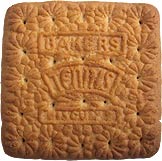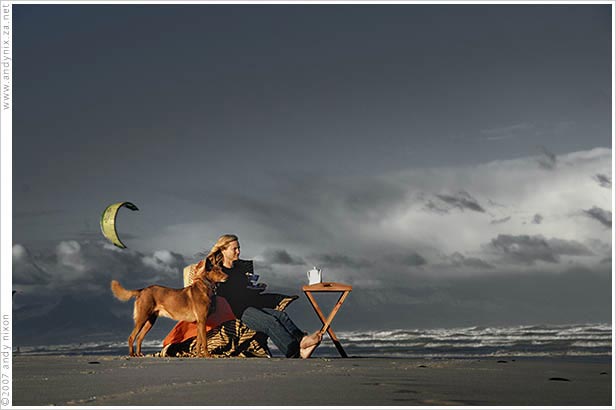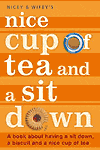Your ViewsKeep your e-mails pouring in, it's good to know that there are lots of you out there with views and opinions. To help you work out what is what, are now little icons to help you see biscuit related themes. And now you can see at a glance which are the most contested subjects via this graph (requires Flash 6.0 plugin). Please keep your mails coming in to nicey@nicecupofteaandasitdown.com | If you like, you can use this search thingy to find stuff that matches with any of the icons you pick, or use the fantastic free text search, Yay! | Your e-Mails |
| Bob and Amanda |
Nicey, Wifely, et al,
Where can I get a good cuppa in London? Do British Rail cafeteria still exist?
Robert
Australia |
| Nicey replies: Lots of places although it would seem you need to go anywhere that Tony Blair doesn't.
There are cafes in most London stations but they are tend to deal in charmless Danish pastries and paninnis. Your tea will be subject to whatever nameless catering teabag they shove in your paper cup and how hot their water is. Both of these important factors are usually beyond your knowledege or control.
I find the best places to simply be any every day back street cafe which London is full of. If they do bacon rolls or egg and chips then the tea should be up to scratch. The really good ones have giant teapots and use giant catering tea bags. I was very excited to be presented with one of these giant tea bags when I went to the Fields Cafe in Dalston.
Then of course you should check out definitive back street cafe site eggbaconbeansandchips and its sister site ateaandathink. |
| |
| Alison Debenham |
Hi Nicey etc etc
My younger daughter found this site, which may be of interest to you - a little pricey for the first order, but I'm sure you're worth it, or it could be a very special present - sounds like a fun idea!
www.blendsforfriends.com
Best wishes to all
Alison |
| Nicey replies: Yes bet it costs an arm and a leg, always suspicious when there isn't a sniff of a price anywhere. He would be best off just ripping open some bags of PG Tips for us and bunging them in one of his fancy little tins, then writing some stuff on the side about how we only really like PG Tips.
As sophisticated as ever
Nicey |
| |
Andy Nix

Bakers Tennis Biscuits Review |
Hi Nicey & The Wife,
I stumbled onto your website and was delightfully, well, delighted! It was so refreshingly... I'm struggling to find the right words, but suffice to say that it inspired me to take set up a tea and biscuits photo. I envisioned a stormy day with wind and waves and clouds and someone calmly enjoying a nice cup of tea and a sit down in all the chaos... and discovered it's a lot harder than I thought! But I'm actually quite happy with the results, and my friend Sally is still my friend.
I send out a sort-of-weekly pic of the week email, and this is this week's email - thanks for the inspiration and a wonderfully nutty website!
Andy
 |
| Nicey replies: Andy,
Very dramatic tea drinking indeed, and great light. I shall assume Tennis Biscuits if I may.
|
| |
| Romie Stott |
Dear Nicey,
I just read your e-mail from Richard with regards to the foolhardy practice of adding milk to tea before the water, leading to a very weak cuppa. You both theorized that the milk formed some kind of protective barrier around the leaves and or bag, such that the tea was unable to break free. I suspect the explanation is much more simple: the milk was cold, or at least colder than the piping hot water that comes out of the kettle. The tea didn't brew properly because the milk cooled the water before it reacted with the tea (heat being one of the best ways to get a solution to supersaturate). If Richard is really attached to this method, he might try to find "iced tea" tea bags, which are specially formulated to brew in room-temperature water, but he's probably better off just adding the milk afterward.
Regards,
Romie Stott
P.S. On the subject of iced tea, Steve's e-mail about the flask-brewed Indian-style teas made me think of sun tea. Clearly there must be some chemical reaction process on which causes tea to eventually un-stew and turn into something new and palatable, a bit like the juice-wine-vinegar or milk-curdled milk-cheese continuum. I hope you will speak to the highest members of government about funding an investigative panel of top scientists. |
| Nicey replies: We have had a few replies about the temperature being lowered by the milk. So I've just tried experimenting with a tea bag in some cold water, then pouring in the boiled water. The tea bag took a little longer to get going, I think because the leaves had clumped together a bit in the cold water. After a few stirs everything appeared to be proceeding as normal. When it had all reached the right colour I added the milk. I was genuinely surprised to find that it tasted wrong, sort of flat and dull with something missing.
So its my conclusion that its not the temperature of the final brew that is the is the issue, a few degrees here or there is not going to greatly affect things. After all I've produced much better cuppas with water that hadn't just been boiled when forced to by circumstance. It is however crucial that the dry leaves are hydrated with boiling, (or as near to as you can get) water. I suspect once again, as we have discussed in the past with regard to tea stewing, it's got something to do the structure of the cell walls in the dried tea leaves and how they allow the passage of solutes. I would hypothesise that the cold water/milk sets the tea leaf into a different configuration to that of boiling water, and that this is not undone by the subsequent addition of boiling water.
Also, grotty as this cup of tea was, it was not as woeful as if I had added milk first. I still suspect that the droplets of fat in the milk will adhere and smother the tea leaves providing them with patches of water proofing. The casein protein in the milk is also bound to shake things up at a molecular level, weakly bonding with this that and the other and denaturing as the boiling water arrives.
As to top scientists investigating, they probably already have but can't reveal their results for fear of causing mass hysteria in the populace. |
| |
| Richard Morgan |
Dear Nicey.
I made a cup of tea today and made a disturbing discovery. Maybe you or someone else could explain it to me.
I took my cup and placed a teabag into the bottom as usual, but instead of adding the water first I added the milk.
This was tricky as I had to pre-judge the ammount of milk nessesary to make the tea in advance, though this was not my problem at all. The problem was that the milk seemed to smother the tea leaves from within the bag and seriously hinder the performance of the teabag when the hot water was added. It was as if the milk had created a protective barrier around the tea leaves, thus retaining the brown goodness and leaving me with a rather weak cup of tea.
Please try this out and tell me how you get on.
Richard Morgan |
| Nicey replies: Richard,
What you have stumbled over is perhaps one the best known ways of making a really dreadful cup of tea. As such I have no intention at all of subjecting myself to it, having previously been on the receiving end of one or two of those. There are some twisted individuals who actually prefer their tea made in this deviant fashion, and we often cite them as examples of how peoples taste and ideas of what makes a good cuppa vary widely, and as examples of people who don't know how to make tea properly.
I often put this method, if it can be called that, down to a move from instant coffee drinking to tea drinking. I also suspect that they were largely living out a solitary existence, certainly as far as tea making goes when they adopted it. Any sane tea drinker would quickly try and show them the error of their ways. You could get away with it for instant coffee but not for tea.
I think you have made an intuitive evaluation of what's going a wrong. Clearly the milk bungs up the tea leaves and tea bag holes, at some level molecular or microscopic. Whether that is due to lipids or proteins or both I'll leave to your imagination.
In your case perhaps it was some primal hunter-gather type mechanism that kicked in to make you try this iffy tea building. No doubt when we wonder who the curious individual was who thought of eating raw oysters, or decided to eat the really badly gone off milk and call it cheese it was somebody much like yourself. Watch yourself with such idle thrill seeking you'll be moving up to auto asphyxiation next. |
| |
|
|
|





